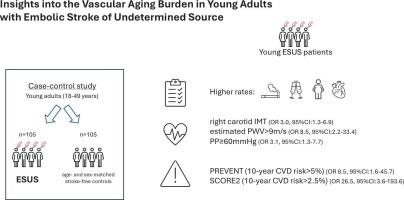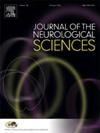Insights into the vascular aging burden in young adults with embolic stroke of undetermined source
IF 3.2
3区 医学
Q1 CLINICAL NEUROLOGY
引用次数: 0
Abstract
Introduction
This study investigates pre-atherosclerotic changes, vascular aging and clinical cardiovascular disease (CVD) risk scores in young adults with embolic stroke of undetermined source (ESUS) compared to stroke-free controls.
Methods
The study included 105 ESUS patients and 105 age- and sex-matched stroke-free controls aged 18 to 49 years. Clinical and laboratory characteristics and arterial stiffness measurements were recorded. Vascular aging indexes were defined according to age-adapted values and definitions. Clinical scores PREVENT and SCORE2 were calculated. Associations were investigated using logistic regression adjusting for several factors associated with vascular aging.
Results
Young ESUS patients had higher rates of central obesity, smoking, heavy alcohol consumption and patent foramen ovale compared to stroke-free controls. ESUS patients had higher odds of having excessive intima-media thickness (IMT) of the right carotid artery (OR 3.02, 95 %CI:1.31–6.92). They also had significantly higher odds of having elevated estimated pulse wave velocity (ePWV>9 m/s; OR 8.48, 95 %CI:2.16–33.4), high pulse pressure (PP ≥ 60 mmHg; OR 3.13, 95 %CI:1.28–7.68), a 10-year CVD risk above 5 % based on the PREVENT score (OR 8.53, 95 %CI:1.59–45.7), and a 10-year CVD risk above 2.5 % based on SCORE2 (OR 26.5, 95 %CI:3.6–193.6) estimated at the time of their stroke.
Conclusions
Despite a low burden of established CVD, young ESUS patients harbored pathology in the vascular aging measures including IMT, ePWV, and PP. Clinical risk scores such as PREVENT and SCORE2 may effectively identify young adults at high risk of developing ESUS.

来源不明的年轻成人栓塞性中风的血管老化负担
本研究调查了来源不明的年轻成人栓塞性卒中(ESUS)患者的动脉粥样硬化前改变、血管老化和临床心血管疾病(CVD)风险评分,并与无卒中对照进行了比较。方法研究纳入105例ESUS患者和105例年龄和性别匹配的无卒中对照,年龄在18至49岁之间。记录临床和实验室特征以及动脉硬度测量。根据年龄适应值和定义定义血管老化指标。计算临床评分prevention和SCORE2。使用逻辑回归对与血管老化相关的几个因素进行校正,研究了相关关系。结果年轻ESUS患者中心性肥胖、吸烟、酗酒和卵圆孔未闭的发生率高于无卒中对照组。ESUS患者右侧颈动脉内膜-中膜厚度(IMT)过高的几率更高(OR 3.02, 95% CI: 1.31-6.92)。他们也有更高的几率有较高的估计脉搏波速度(9米/秒;OR 8.48, 95% CI: 2.16-33.4),高脉压(PP≥60 mmHg;OR 3.13, 95% CI: 1.28-7.68),基于prevention评分的10年心血管疾病风险高于5% (OR 8.53, 95% CI: 1.59-45.7),以及基于SCORE2的10年心血管疾病风险高于2.5% (OR 26.5, 95% CI: 3.6-193.6)。结论年轻ESUS患者的心血管疾病负担较轻,但IMT、ePWV、PP等血管老化指标均存在病变。预防和SCORE2等临床风险评分可有效识别ESUS的高危年轻人。
本文章由计算机程序翻译,如有差异,请以英文原文为准。
求助全文
约1分钟内获得全文
求助全文
来源期刊

Journal of the Neurological Sciences
医学-临床神经学
CiteScore
7.60
自引率
2.30%
发文量
313
审稿时长
22 days
期刊介绍:
The Journal of the Neurological Sciences provides a medium for the prompt publication of original articles in neurology and neuroscience from around the world. JNS places special emphasis on articles that: 1) provide guidance to clinicians around the world (Best Practices, Global Neurology); 2) report cutting-edge science related to neurology (Basic and Translational Sciences); 3) educate readers about relevant and practical clinical outcomes in neurology (Outcomes Research); and 4) summarize or editorialize the current state of the literature (Reviews, Commentaries, and Editorials).
JNS accepts most types of manuscripts for consideration including original research papers, short communications, reviews, book reviews, letters to the Editor, opinions and editorials. Topics considered will be from neurology-related fields that are of interest to practicing physicians around the world. Examples include neuromuscular diseases, demyelination, atrophies, dementia, neoplasms, infections, epilepsies, disturbances of consciousness, stroke and cerebral circulation, growth and development, plasticity and intermediary metabolism.
 求助内容:
求助内容: 应助结果提醒方式:
应助结果提醒方式:


